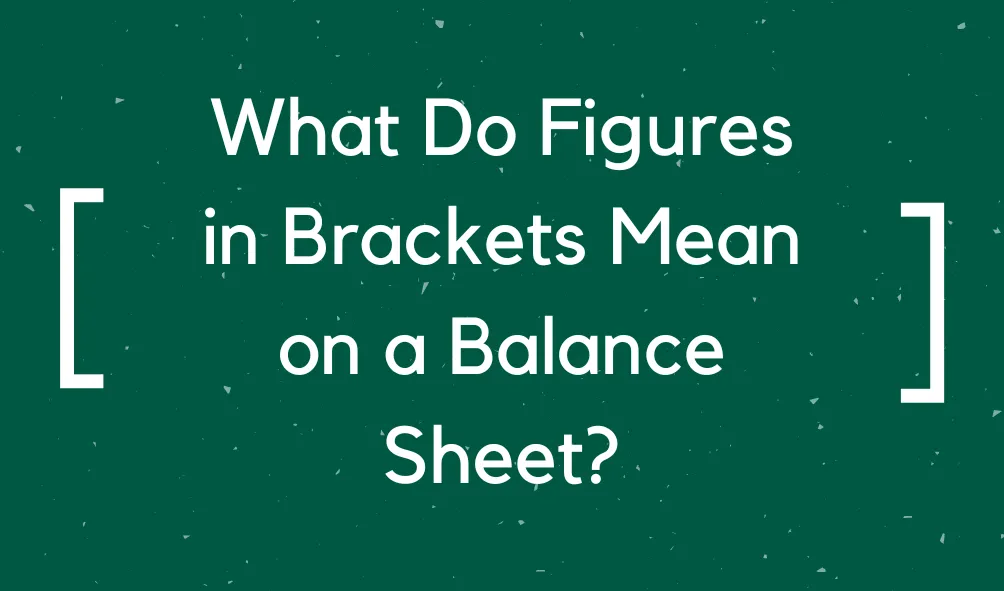The Ensemble Bookkeeping Blog

What Do Figures in Brackets Mean on a Balance Sheet?
Has your accountant provided you with financial statements for your business and left you to try and interpret what it all means? You would like to understand what all these figures mean to your business, but you really don’t want to ask because you know you are on their clock and your bill is quickly rising. Let’s answer one of your questions in this article and explain what those figures in brackets mean on your Balance Sheet.
Most of the time a bracket or parenthesis on a Balance Sheet means that that particular figure is a negative number. Depending on where in the Balance Sheet the bracket or parenthesis appear could tweak what this negative balance actually means. For instance:
· A negative amount
· A bank account is overdrawn, etc.
· Losses
· Net Income is in brackets due to business operating at a loss.
· A debit balance in an account that usually has a credit balance, or vice versa
· If you were to have paid off a credit card, but then made a return that was credited back to the card that would show a negative balance.
To the untrained eye, it can at times be confusing when looking at your balance sheet to know if these numbers in brackets are due to accounting errors either made by yourself or accountant or if they might be warning signs of something you need to address in your business.
A Negative Amount
As a general rule in mathematics a bracket or parenthesis are used to indicate a negative number. Given that accounting is a subset of mathematics it would make sense that this principle is carried over in the standard financial reports that bookkeepers and accountants generate such as the Balance Sheet, Income Statement (also known as the Profit and Loss), and the Statement of Cash Flows.
A Negative Amount in Assets
If you find a line item under your assets such as a bank account that has a number in brackets that could be cause for alarm or no big deal. Most likely you have either overdrawn your account, you have written more checks than you have deposited in the bank but they haven’t cleared yet, or you have errors in the transactions you have entered or your reconciliation is incorrect and/or outdated.
Assuming you have online access to your bank’s website you should be able to easily check and see if the bank account actually has funds. If the account is actually in the hole and you have the financial resources to correct that I would recommend you immediately bring that account balance back up to a positive number to avoid any penalties that may be incurred with bounced checks.
If there is money in the bank but you are showing a negative or bracketed figure on your Balance Sheet then we have to dig a little deeper for an answer.
Assuming that your bookkeeping is up to date and your accounts have been recently reconciled one likely cause for this negative balance could be you have outstanding checks that have not yet been cashed.
Shortly after I opened my homecare business I hired a marketer for a short period of time. He didn’t last too long, but he did receive one commission check for $0.17. My marketer never cashed that check (I imagine that it is probably framed and hanging on his wall now.)
For years I would see that $0.17 check hanging out when I did my reconciliations. My bank account balance and the amount on my Balance Sheet would be off by $0.17 each month (and this was all correct using standard accounting principles.)
In time, these types of expenses started adding up to the point that there was a significant difference between the totals on my Balance Sheet and the actual amount I had in the bank account and led to my Balance Sheet showing negative figures for some of my accounts.
(Since becoming a Bookkeeping Professional I have learned how to resolve these long outstanding checks and will probably write a future blog article about that. In the meantime, if you would like to know how to address these same issues feel free to reach out to us at Ensemble Bookkeeping.)
Often times we meet with potential clients who have negative figures in brackets that really shouldn’t be the case can be traced to an incomplete job being done in entering and/or reconciling accounts on a regular basis.
For instance, it is common for business owners to reach out to us for a free consultation and they have never had their accounts reconciled before. If you are unsure of what I mean by reconciling accounts you might fall into this category.
In short, reconciliation is the process that takes place on the same frequency as you receive statements for your bank accounts or loans.
Usually monthly, quarterly, or annually the accounting system such as Quickbooks Online will have a process where starting and ending balances are entered along with the closing date of the statement. Then all the debits and credits are cross-referenced on that statement to ensure that both that all transactions are captured and that none are missing.
If you would like more information about the reconciliation process please feel free to reach out to us at Ensemble Bookkeeping.
A Negative Amount in Liabilities and Equity
Once we cross that midway point of the Balance Sheet understand that the numbers somewhat reverse. At the top of the page when we look at Assets if the report shows $1,000 in a checking account that means you have a grand in the bank. In the middle of the report when we get to Liabilities debit and credit accounts switch so that if your Credit Card account shows $500 it means that you owe $500.
This is all standard GAPP accounting guidelines that it is important you have at least a basic level of understanding.
A Negative Amount in Credit Cards
As mentioned earlier if you are showing a negative number (in brackets or parentheses) in a line item for a Credit Card then there has either been some sort of overpayment or refund to the card, or there is an accounting error. If it is an accounting error then a good bookkeeper or accountant should pick up on that as they review your books.
If there are no accounting issues then the most likely cause of this problem is going to be that an overpayment was made to a credit card, or that some sort of refund or return was credited back to that card. If the credit card is used on a regular basis this is not really something to worry too much about as you will run up new charges and you can reduce future payments by the amount of the credit.
If this card is rarely used it might be worth reaching out to customer service for that card and asking to have a check mailed or wired to your account.
A Negative Amount in Owner Equity
Depending on how your chart of accounts is set up you may have a single line for Owner Equity or you may have two sub-accounts of Owner Equity called Owner Contributions and Owner Distributions. Owner Contributions are funds you have put into the business as equity (not loans). Owner Distribution is money you have pulled out of the business (not payroll.)
If you have the two separate accounts it is going to be expected that the Owner Distribution line is negative and in brackets. If you just have one line this number could be positive or negative depending on if you have put in more equity than you have taken out of the business.
Losses
On a Balance Sheet, the key place you are going to see a loss that would show up in brackets is near the bottom on the Net Income line of the Equity section. This number ties directly to the Income Statement (or Profit and Loss) report.
If your business is showing a profit this number will be positive. If your business is showing a loss for that period then it will be negative.
A debit balance in an account that usually has a credit balance, or vice versa
One of the tougher things for me anyway in learning how to be a bookkeeper was wrapping my head around how credits and debits work in the accounting world. I’m not going to go into a deep explanation of that in this post, but just understand that for the layperson when an accountant uses the words debit and credit it might mean the opposite of what you would assume it means.
I’m going to try and make this point about debit and credit account balances without actually using the terms debit and credit so as not to confuse.
If you are looking at a line item in the Asset section of the Balance Sheet know that most likely it needs to be positive. If it is negative that is something to dig into and address with your Bookkeeping Professional.
If you are looking at a line item in your Liabilities section and it is in brackets then you probably need to address that with your accountant as well. One exception would be if you have a catch-all fund like Ask My Accountant where credits and debits can both be placed that either yourself or your bookkeeper have questions about that need some more explanation to be coded correctly.



